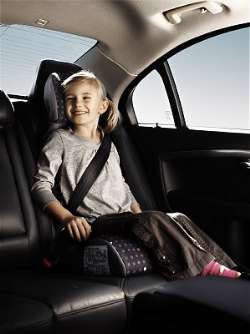|
| |||||
|
Children Should Travel Rearward Facing Until 3-4 Years of Age
4th June, 2007 | ||||
|
Small children should travel in rearward facing child restraints for as long as possible, at least until they are three to four years old. Older children should use a booster cushion until they are 140 cm tall and at least 10-years old. This is Volvo Cars' firm recommendation. The knowledge is based on real life crashes, together with advanced research at Volvo Cars' state-of-the-art crash laboratory. More than 40 years of child safety development "Our first rearward facing child restraint was launched back in 1972," says Lotta Jakobsson, Child Safety Specialist at Volvo Cars Safety Centre. Volvo Cars has also been a guiding force in international co-operations such as the making of the ISOFIX* standard. ISOFIX is a standardised anchoring system that makes it easier to fit a child restraint correctly in any car equipped with the system. *ISOFIX is not yet approved for use in Australia. Based on accident research For example, SIPS (Side-Impact Protection System) and WHIPS (Whiplash Protection System) are direct results of this crash research. "Our engineers identify interesting areas, develop solutions and incorporate them in future Volvo model," says Jakobsson. "When that model is out on the streets, the research of real life car crashes continues to help decide which areas to focus on in next generation. It is a continuous process." The statistical database at Volvo Cars includes more than 4,500 children. The accidents have been studied carefully and reveal the following:
Volvo Cars' Advanced Safety Centre Volvo Cars uses this research together with accident data from real life to enhance road safety for various road users: the driver, the passengers and people outside the car - pedestrians as well as people in other vehicles. "All children must always be restrained properly. They should travel facing the rear until at least the age of three to four and use restraints for older children up to 10 to 12 years of age," says Jakobsson. New safety improvements "Using a booster cushion, integrated or accessory, with the lap belt pulled tight prevents the body from riding underneath the safety belt and forward in a collision," says Jakobsson. The new integrated two-stage booster cushion is also available to the all-new XC70. Another improvement in Volvo's latest car models compared to their predecessors is that the inflatable curtains have been extended by 60 mm. The extended curtain is designed to provide more children of different sizes with effective protection in a side impact. "The integrated two-stage booster cushion in the all-new Volvo V70 and XC70 is the latest addition to Volvo Cars' long history of child safety development," says Jakobsson. "Our researchers now also focus on preventing accidents and protecting travellers in upcoming models." | |||||
ABN 47106248033 |
 |
All rights reserved. |
